Funnelbeaker culture
The Funnel(-neck-)beaker culture, in short TRB or TBK (German: Trichter(-rand-)becherkultur, Dutch: Trechterbekercultuur; Danish: Tragtbægerkultur; c. 4300 BC–c. 2800 BC) was an archaeological culture in north-central Europe. It developed as a technological merger of local neolithic and mesolithic techno-complexes between the lower Elbe and middle Vistula rivers, introducing farming and husbandry as a major source of food to the pottery-using hunter-gatherers north of this line. It was preceded by Lengyel-influenced Stroke-ornamented ware culture (STK) groups/Late Lengyel and Baden-Boleráz in the southeast, Rössen groups in the southwest and the Ertebølle-Ellerbek groups in the north.
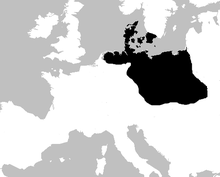 | |
| Geographical range | Europe |
|---|---|
| Period | Neolithic Europe |
| Dates | c. 4300 BC – 2800 BC |
| Preceded by | Ertebølle culture, Dnieper-Donets culture, Linear Pottery culture |
| Followed by | Globular Amphora culture, Pitted Ware culture, Corded Ware culture |
| Chalcolithic Eneolithic, Aeneolithic, or Copper Age |
|---|
|
↑ Stone Age ↑ Neolithic |
|
West Asia
|
|
Metallurgy, Wheel, Domestication of the horse |
|
↓ Bronze Age ↓ Iron Age |
The TRB techno-complex is divided into a northern group including modern northern Germany and southern Scandinavia (TRB-N, roughly the area that previously belonged to the Ertebølle-Ellerbek complex), a western group in the Netherlands between the Zuiderzee and lower Elbe that originated in the Swifterbant culture, an eastern group centered on the Vistula catchment, roughly ranging from Oder to Bug, and south-central groups (TRB-MES, Altmark) around the middle and upper Elbe and Saale. Especially in the southern and eastern groups, local sequences of variants emerged. In the late 4th millennium BC, the Globular Amphora culture (KAK) replaced most of the eastern and subsequently also the southern TRB groups, reducing the TRB area to modern northern Germany and southern Scandinavia. The younger TRB in these areas was superseded by the Single Grave culture (EGK) at about 2800 BC. The north-central European megaliths were built primarily during the TRB era.
Nomenclature
The Funnelbeaker culture is named for its characteristic ceramics, beakers and amphorae with funnel-shaped tops, which were found in dolmen burials.
Geography
The TRB ranges from the Elbe catchment in Germany and Bohemia with a western extension into the Netherlands, to southern Scandinavia (Denmark up to Uppland in Sweden and the Oslofjord in Norway) in the north and to the Vistula catchment in today's Poland in the east.
Variants of the Funnelbeaker culture in or near the Elbe catchment area include the Tiefstich pottery group in northern Germany as well as the cultures of the Baalberge group (TRB-MES II and III; MES = Mittelelbe-Saale), the Salzmünde and Walternienburg and Bernburg (all TRB-MES IV) whose centres were in Saxony-Anhalt.
Settlements
With the exception of some inland settlements such as Alvastra pile-dwelling, the settlements are located near those of the previous Ertebølle culture on the coast. It was characterised by single-family daubed houses c. 12 m x 6 m. It was dominated by animal husbandry of sheep, cattle, pigs and goats, but there was also hunting and fishing. One find assigned to the Funnelbeaker culture is the Bronocice pot from Poland, which shows the oldest known depiction of a wagon, presumably drawn by aurochs whose remains were found with the pot. Primitive wheat and barley was grown on small patches that were fast depleted, due to which the population frequently moved small distances. There was also mining (in the Malmö region) and collection of flintstone (Świętokrzyskie Mountains), which was traded into regions lacking the stone, such as the Scandinavian hinterland. The culture used copper from Silesia, especially daggers and axes.
Religion and graves

The houses were centered on a monumental grave, a symbol of social cohesion. Burial practices were varied, depending on region and changed over time. Inhumation seems to have been the rule. The oldest graves consisted of wooden chambered cairns inside long barrows, but were later made in the form of passage graves and dolmens. Originally, the structures were probably covered with a mound of earth and the entrance was blocked by a stone. The Funnelbeaker culture marks the appearance of megalithic tombs at the coasts of the Baltic and of the North sea, an example of which are the Sieben Steinhäuser in northern Germany. The megalithic structures of Ireland, France and Portugal are somewhat older and have been connected to earlier archeological cultures of those areas. At graves, the people sacrificed ceramic vessels that contained food along with amber jewelry and flint-axes.
Flint-axes and vessels were also deposited in streams and lakes near the farmlands, and virtually all Sweden's 10,000 flint axes that have been found from this culture were probably sacrificed in water.
They also constructed large cult centres surrounded by pales, earthworks and moats. The largest one is found at Sarup on Fyn. It comprises 85,000 m2 and is estimated to have taken 8000 workdays. Another cult centre at Stävie near Lund comprises 30,000 m2.
Ethnicity and language
In the context of the Kurgan hypothesis (or steppe hypothesis), the culture is seen as non-Indo-European, representing a culture of Neolithic origin, as opposed to the Indo-European-language-speaking peoples (see Yamna culture) who later intruded from the east.[1] Marija Gimbutas postulated that the political relationship between the aboriginal and intrusive cultures resulted in quick and smooth cultural morphosis into the Corded Ware culture.[2] By contrast, a number of other archaeologists in the past have proposed that the Corded Ware culture was a purely local development of the Funnelbeaker culture,[3] which has been debunked by genetics.[4]
Bronocice Pot
The Bronocice pot, discovered in a village in Gmina Działoszyce, Świętokrzyskie Voivodeship, near Nidzica River, Poland, is a ceramic vase incised with the earliest known image of a wheeled vehicle. It was dated by the radiocarbon method to 3635–3370 BC,[5] and is attributed to the Funnelbeaker culture. Today it is housed in the Archaeological Museum of Cracow (Muzeum Archeologiczne w Krakowie), Poland.
The picture on the pot symbolically depicts key elements of the prehistoric human environment. The most important component of the decoration are five rudimentary representations of what seems to be a wagon. They represent a vehicle with a shaft for a draught animal, and four wheels. The lines connecting them probably represent axles. The circle in the middle possibly symbolizes a container for harvest. Other images on the pot include a tree, a river and what may be fields intersected by roads/ditches or the layout of a village.
The Bronocice Pot suggests the existence of wagons in Central Europe as early as in the 4th millennium BC. They were presumably drawn by aurochs whose remains were found with the pot. Their horns were worn out as if tied with a rope, possibly a result of using a kind of yoke.[6]
Based on Bronocice discovery, several researchers (Asko Parpola and Christian Carpelan),[6] pointed out that "Indo-European languages possess inherited vocabulary related to wheeled transport", thus providing new research information about the origin of the Indo-European; "the wheeled vehicles were first invented around the middle of the fourth millennium BC." In his review Theoretical Structural Archeology, Geoff Carter, writes: "The site was occupied during the Funnel Beaker or TBR culture phase, one of a complex group of cultures that succeeded the LBK in northern Europe, in the Fifth and Fourth Millennia BC. Bones from the pit in which the pot was found gave radiocarbon dates of around 3635–3370 BC, which, as the excavators pointed out, is earlier than dates for pictograms of wheels from the Sumerian Uruk Period."[7]
In nearby Olszanica 5000 BCE a longhouse was constructed with 2.2 m wide doors, presumably for wagon entry. This building was 40 m long with 3 doors.[8]
- The Bronocice Pot
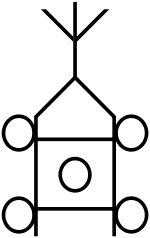 A representation of the key element on the pot
A representation of the key element on the pot
Archaeology
- Archaeological state museum Schleswig-Holstein, Gottorf Castle
- Archaeological state museum Schleswig-Holstein, Gottorf Castle
- Archaeological state museum Schleswig-Holstein, Gottorf Castle
- Archaeological state museum Schleswig-Holstein, Gottorf Castle
 Early neolithic mug, Fischbeker Heide, Germany.
Early neolithic mug, Fischbeker Heide, Germany. various artefacts including a stone axe and copper necklace
various artefacts including a stone axe and copper necklace- model wheels
 Plan of the "oval dolmen" in Bogø and drawing of the grave goods. A. P. Madsen 1896.
Plan of the "oval dolmen" in Bogø and drawing of the grave goods. A. P. Madsen 1896. Plan of the "round dolmen" in Hjortegårdene and drawing of the burial and the grave goods, A. P. Madsen 1896
Plan of the "round dolmen" in Hjortegårdene and drawing of the burial and the grave goods, A. P. Madsen 1896 Plan of the collective burials or "passage grave" in Uggerslev. A. P. Madsen 1896
Plan of the collective burials or "passage grave" in Uggerslev. A. P. Madsen 1896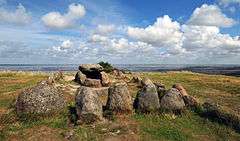 Dolmen in Harhoog
Dolmen in Harhoog Round dolmen in Gribskov
Round dolmen in Gribskov Dolmen in North Zealand
Dolmen in North Zealand- Oval or Long dolmen near Korsør
 Passage grave at Hulehøj on the island of Bogø
Passage grave at Hulehøj on the island of Bogø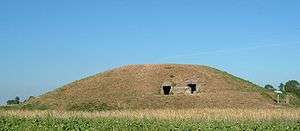 Klekkende Høj, Denmark, c. 3500-2800 BC
Klekkende Høj, Denmark, c. 3500-2800 BC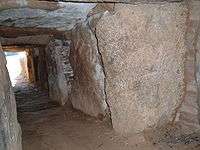 Klekkende Høj, interior
Klekkende Høj, interior Dolmen in Mols, Denmark
Dolmen in Mols, Denmark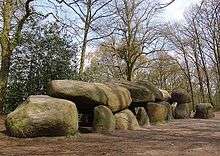 Dolmen in the Netherlands
Dolmen in the Netherlands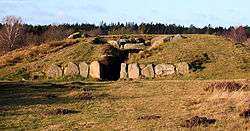 Tustrup jaettestue passage grave in Denmark
Tustrup jaettestue passage grave in Denmark Model of the Denghoog passage grave in Denmark
Model of the Denghoog passage grave in Denmark Denhoog passage grave interior
Denhoog passage grave interior Model of a Funnelbeaker culture house, Germany. Bomann-Museum
Model of a Funnelbeaker culture house, Germany. Bomann-Museum Reconstruction of a Funnelbeaker culture house
Reconstruction of a Funnelbeaker culture house
Genetics
Thus the question of continuity versus migration at the cusp of the cultural change was of interest to geneticists specialising in ancient DNA. A sample of Corded Ware people from Germany has been modelled as approximately three-quarters Yamnaya, clear evidence of migration into the heartland of Europe from its eastern periphery.[9]
Ancient DNA extracted from three individuals ascribed to a TRB horizon in Gökhem, Sweden, were found to possess mtDNA haplogroups H, J, and T.[10]
It has been suggested that the Funnelbeaker culture was the origin of the gene allowing adults of Northern European descent to digest lactose. It was claimed that in the area formerly inhabited by this culture, prevalence of the gene is virtually universal.[11] A paper published in 2007 by Burger et al.[12] indicated that the genetic variant that causes lactase persistence in most Europeans (–13,910*T) was rare or absent in early farmers from central Europe. A study published by Yuval Itan and colleagues in 2010 [13] clearly shows this. A study published in 2009, also by Itan et al.,[14] suggests that the Linear Pottery culture (also known as Linearbandkeramik or LBK), which preceded the TRB culture by some 1,500 years, was the culture in which this trait started to co-evolve with the culture of dairying.
A November 2015 genetic study published in Nature included an analysis of three individuals of the Baalberge group of the Funnelbeaker culture. The two males surveyed were found to be carriers of the paternal haplogroups I and R1b1a.[15][16]
In a 2017 genetic study published in Nature, the remains of three individuals ascribed to the Salzmünde group of the Funnelbeaker culture was analyzed. Of the two samples of Y-DNA extracted, one belonged to G2a2a1, and one belonged to IJK. mtDNA extracted were two samples of H2, and one sample of U3a1.[17][18]
See also
- Western Linear Pottery culture
- Pit–Comb Ware culture
- Cardium Pottery culture
- Vlaardingen culture
- Prehistory and protohistory of Poland
- Stone Age Poland § Neolithic
- Scandinavian prehistory
- Prehistoric Germany
- Prehistoric Europe
- Old Europe
- Neolithic Europe
- Invention of the wheel
Footnotes
- Iversen, R. & Kroonen, G. 2017. Talking Neolithic: Linguistic and Archaeological Perspectives on how Indo-European was Implemented in Southern Scandinavia. American Journal of Archaeology, vol. 121, no. 4, p. 511–525.
- Gimbutas, Marija (1997). The Kurgan Culture and the Indo-Europeanization of Europe: Selected Articles From 1952 to 1993 (Journal of Indo-European studies monograph). Institute for the Study of Man. p. 316. ISBN 9780941694568.
- For example Pre- & protohistorie van de lage landen, onder redactie van J.H.F. Bloemers & T. van Dorp 1991. De Haan/Open Universiteit. ISBN 90-269-4448-9, NUGI 644.
-
- Haak, Wolfgang (June 11, 2015). "Massive migration from the steppe was a source for Indo-European languages in Europe". Nature. Nature Research. 522: 207–211. doi:10.1038/nature14317. PMC 5048219. PMID 25731166. Retrieved January 7, 2020.CS1 maint: ref=harv (link)
- Anthony, David A. (2007). The horse, the wheel, and language: how Bronze-Age riders from the Eurasian steppes shaped the modern world. Princeton, NJ: Princeton University Press. p. 67. ISBN 978-0691058870.
- David W. Anthony, 2007
- Theoretical Structural Archeology. by Geoff Carter
- "Olszanica Longhouse"
- Haak, W. et al. 2015. Massive migration from the steppe is a source of Indo-European languages, Nature.
- Malmstrom, H. et al. 2009. Ancient DNA Reveals Lack of Continuity between Neolithic Hunter-Gatherers and Contemporary Scandinavians. Current Biology 19:1–5
- Milk allergy "caused by Stone Age gene" - Telegraph Media Group Limited, 27 February 2007
- J. Burger, M. Kirchner, B. Bramanti, W. Haak, M. G. Thomas (2007) Absence of the Lactase-Persistence associated allele in early Neolithic Europeans. Proceedings of the National Academy of Sciences USA 104: pp. 3736–3741,
- Yuval Itan, Bryony L. Jones, Catherine J. E. Ingram, Dallas M. Swallow and Mark G. Thomas (2010), A worldwide correlation of lactase persistence phenotype and genotypes, BMC Evolutionary Biology 10, no. 36, pp. 1–11.
- Yuval Itan, Adam Powell, Mark A. Beaumont, Joachim Burger and Mark G. Thomas, The Origins of Lactase Persistence in Europe, PLoS Computation Biology, vol. 5, no 8 (2009): e1000491.
- Mathieson 2015.
- Mathieson 2018.
- Lipson 2017.
- Narasimhan 2019.
Sources
| Wikimedia Commons has media related to Funnelbeaker culture. |
- J. P. Mallory, "TRB Culture", Encyclopedia of Indo-European Culture, Fitzroy Dearborn, 1997.
- Mathieson, Iain (November 23, 2015). "Genome-wide patterns of selection in 230 ancient Eurasians". Nature. Nature Research. 528 (7583): 499–503. doi:10.1038/nature16152. PMC 4918750. PMID 26595274. Retrieved January 7, 2020.CS1 maint: ref=harv (link)
- Mathieson, Iain (February 21, 2018). "The Genomic History of Southeastern Europe". Nature. Nature Research. 555 (7695): 197–203. doi:10.1038/nature25778. PMC 6091220. PMID 29466330. Retrieved January 7, 2020.CS1 maint: ref=harv (link)
- Lipson, Mark (November 16, 2017). "Parallel palaeogenomic transects reveal complex genetic history of early European farmers". Nature. Nature Research. 551: 368–372. doi:10.1038/nature24476. PMC 5973800. PMID 29144465. Retrieved January 8, 2020.CS1 maint: ref=harv (link)
- Narasimhan, Vagheesh M. (September 6, 2019). "The formation of human populations in South and Central Asia". Science. American Association for the Advancement of Science. 365 (6457). bioRxiv 10.1101/292581. doi:10.1126/science.aat7487. PMC 6822619. Retrieved January 8, 2020.CS1 maint: ref=harv (link)
- Joachim Preuß. 1996. Das Neolithikum in Mitteleuropa, Kulturen - Wirtschaft
- Müller, Johannes (2011), Megaliths and Funnel Beakers: Societies in Change 4100–2700 BC, Drieendertigste Kroon-Voordracht, Amsterdam
- Nationalencyklopedin
- Wade, Nicholas, "The Twists and Turns of History, and DNA", The New York Times March 12, 2006.
- Pedersen, Hilthart, "Die jüngere Steinzeit auf Bornholm", München & Ravensburg 2008.